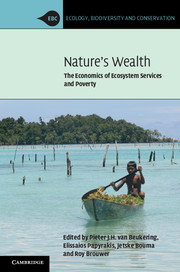Book contents
- Frontmatter
- Contents
- List of contributors
- Acknowledgements
- 1 The economics of ecosystem services and poverty
- Part I Biodiversity-related ecosystem services
- Part II Marine-related ecosystem services
- 5 The role of marine protected areas in alleviating poverty in the Asia-Pacific
- 6 Economics of conservation for the Hon Mun Marine Protected Area in Vietnam
- 7 A multi-criteria approach to equitable fishing rights allocation in South Africa’s Western Cape
- Part III Forest-related ecosystem services
- Part IV Water-related ecosystem services
- Part V Land-related ecosystem services
- Index
- References
5 - The role of marine protected areas in alleviating poverty in the Asia-Pacific
Published online by Cambridge University Press: 05 July 2013
- Frontmatter
- Contents
- List of contributors
- Acknowledgements
- 1 The economics of ecosystem services and poverty
- Part I Biodiversity-related ecosystem services
- Part II Marine-related ecosystem services
- 5 The role of marine protected areas in alleviating poverty in the Asia-Pacific
- 6 Economics of conservation for the Hon Mun Marine Protected Area in Vietnam
- 7 A multi-criteria approach to equitable fishing rights allocation in South Africa’s Western Cape
- Part III Forest-related ecosystem services
- Part IV Water-related ecosystem services
- Part V Land-related ecosystem services
- Index
- References
Summary
Introduction
Small-scale fishers in developing countries depend heavily on near-shore marine fish capture (Pauly 2006, SOFIA 2008). Yet marine fisheries in many developing countries are underregulated and overfished (Agnew et al. 2009, Le Gallic and Cox 2006, Varkey et al. 2009). Global marine capture fish production peaked in the mid-1980s, and one in three marine fisheries are now considered overfished (SOFIA 2008, Worm et al. 2009). The overlapping issues of local livelihoods and fisheries management are particularly apparent in coastal coral reefs.
Globally, the area called the ‘Coral Triangle’ is the epicentre for coral and marine fish diversity (Allen 2008, Allen and Erdmann 2009, Veron et al. 2009). This area of Indonesia, Malaysia, the Philippines, Papua New Guinea and the Solomon Islands is where the challenges of enhancing livelihoods, regulating fisheries and conserving coral reefs intersect. Of the 296 million people in the Coral Triangle area, more than 168 million people live below the international income poverty line (Ravallion et al. 2009) and there are an estimated 63 million people in the Coral Triangle living within 20 km of a coral reef (authors’ GIS calculations). Marine ecosystems play an important role in the subsistence of many people in the Coral Triangle, and there is a growing emphasis in the region on the use of MPAs as fisheries management and conservation tools.
- Type
- Chapter
- Information
- Nature's WealthThe Economics of Ecosystem Services and Poverty, pp. 115 - 133Publisher: Cambridge University PressPrint publication year: 2013
References
- 2
- Cited by



